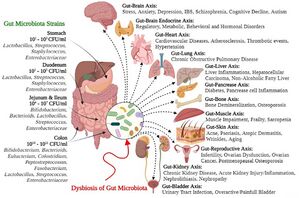Gut microbiota: Difference between revisions
From IDWiki
No edit summary |
(added picture) |
||
| Line 10: | Line 10: | ||
== Members == |
== Members == |
||
| + | [[File:Gastrointestinal flora.jpg|alt=Gut microbial strains and negative health outcomes of gut microbial dysbiosis|thumb|Gut microbial strains and negative health outcomes of gut microbial dysbiosis. From: Afzaal et al. Human gut microbiota in health and disease: Unveiling the relationship. Front Microbiol. 2022 Sep 26;13:999001. doi: 10.3389/fmicb.2022.999001. PMID: 36225386; PMCID: PMC9549250.]] |
||
* A healthy gut microbiota is dominated by bacteria in the phyla [[Bacteroidetes]] or [[Firmicutes]], followed by [[Actinobacteria]] and [[Verrucomicrobia]] |
* A healthy gut microbiota is dominated by bacteria in the phyla [[Bacteroidetes]] or [[Firmicutes]], followed by [[Actinobacteria]] and [[Verrucomicrobia]] |
||
* Varies by location |
* Varies by location |
||
Latest revision as of 14:05, 19 June 2023
Background
- The gastrointestinal tract is normally colonized with a number of microbes
- Comprised of an estimated 35,000 bacterial species
- The gut flora are impacted by:
- Mode of delivery at birth (Cesarean section versus vaginal delivery)
- Diet during infancy (breast milk versus formula)
- Diet during adulthood (plant-based or meat-based)
- Use of antimicrobials
- May play a role in a number of diseases
Members
- A healthy gut microbiota is dominated by bacteria in the phyla Bacteroidetes or Firmicutes, followed by Actinobacteria and Verrucomicrobia
- Varies by location
- Esophagus: Bacteroides, Gemella, Megasphaera, Pseudomonas, Prevotella, Rothia, Streptococcus, Veillonella
- Stomach: Streptococcus, Lactobacillus, Prevotella, Enterococcus, Helicobacter pylori
- Small intestine: Bacteroides, Clostridium, Streptococcus, Lactobacillus, Proteobacteria, Enterococcus
- Cecum: Lachnospira, Roseburia, Butyrivibrio, Ruminococcus, Fecalibacterium, Fusobacterium
- Colon: Bacteroides, Clostridium, Prevotella, Porphyromonas, Eubacterium, Ruminococcus, Streptococcus, Enterobacterium, Enterococcus, Lactobacillus, Peptostreptococcus, Fusobacterium
Further Reading
- Role of the normal gut microbiota. World J Gastroenterol. 2015;21(29):8787-803. doi: 10.3748/wjg.v21.i29.8787. PMID: 26269668; PMCID: PMC4528021.
